Bridging Gaps through Empowerment, Resources and Compassion
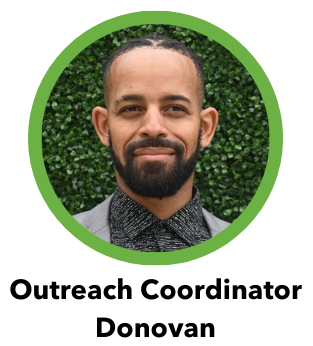 “It’s brought very sincere moments for me that have opened my eyes and makes me really love the work that my team and I do,” Downtown Santa Monica (DTSM) Outreach Coordinator Donovan Wilkes said reflecting on his work with individuals experiencing homelessness.
“It’s brought very sincere moments for me that have opened my eyes and makes me really love the work that my team and I do,” Downtown Santa Monica (DTSM) Outreach Coordinator Donovan Wilkes said reflecting on his work with individuals experiencing homelessness.
Through determination, repeat interactions and immense patience, Donovan and his team of Outreach Ambassadors in DTSM make a real difference in the lives of people who are unhoused by connecting them with community resources.
Every day, Donovan loads his backpack with supplies to serve street residents in DTSM and then hits the streets on foot. His typical walking route includes Downtown’s Promenade and other hotspots where he finds some familiar faces — the regulars of the street community — hanging out. His goal each day is to meet and greet people who are unhoused, offer them connections to resources and generally form relationships with them.
When speaking to someone, he always asks if they “know anyone” who might be looking for services. By asking if they know someone and not if they need the services themselves, the people he talks to don’t feel pressured by his presence. If they’re interested in information, Donovan will share it, but if they’re not, he’ll just carry on with his walk and plan to try again another day. For the regulars, he’ll just see how they’re doing or if anything new is going on.
These conversations are generally light and friendly. As he makes his way through the district, he radios his other team members or messages them on their WhatsApp group to see what is happening in the other areas covered by the team. He keeps a lookout for other social service providers to say hello or join forces and walk together to nurture a working relationship toward a common goal of providing solutions for people on the streets.
Donovan has worked with Block by Block (BBB) off and on since 2015, first as a Safety Ambassador in West Hollywood and later an Outreach Specialist for Westwood in 2017. At Westwood, he got the Outreach Program up and running and was promoted to Operations Manager within two years, where he stayed until 2020. After a brief hiatus working in the non-profit field, Donovan returned to BBB in 2022 and began working with DTSM as an Outreach Coordinator, where he leads a small but mighty team of three Outreach Ambassadors.
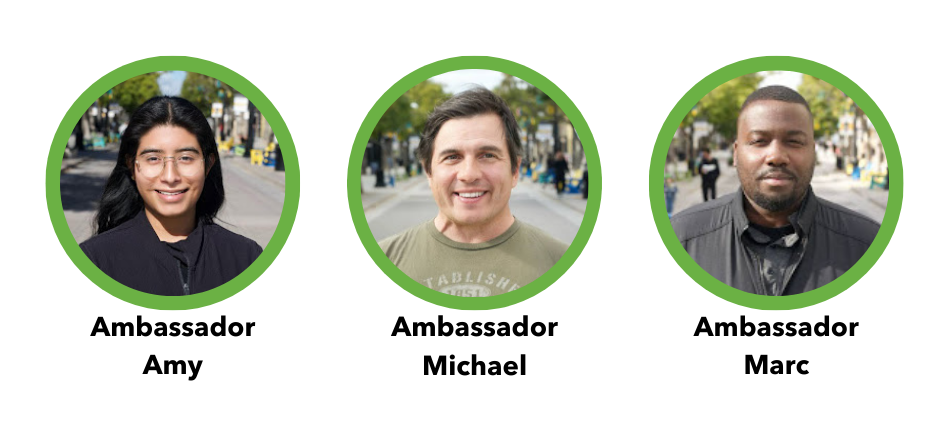
The Outreach Team and the Area They Cover
BBB’s dynamic Outreach Team led by Donovan consists of three dedicated Outreach Ambassadors — Amy, Michael and Marc — who all worked in community outreach before they joined the team. Their experience and pre-existing relationships with social service providers have helped prepare them for the work they do each day.
The DTSM Outreach Team efforts are focused on downtown and three parks: Palisades, Reed and Tongva. The parks offer an enticing environment for members of the street population with places to sit, lay down or hide — all with less enforcement than downtown. Palisades Park also faces the ocean, providing a scenic view for transients just passing through the district and local street residents alike.
Beyond this core team, BBB provides the added resource of an experienced outreach expert in Director of Outreach, Chico Lockhart. Chico has an uncanny ability to mix humor and fun with serious, informative, real-world training. He is an asset to all BBB Outreach Teams nationwide, providing valuable insight, direction and advice. He travels to check in with BBB Outreach Programs across the country and meets with the teams virtually every month for essential mental health training, collaborative discussions and more.
“The [DTSM] team has a great leader who is very knowledgeable about services and how to get people help in the community.” Chico said. “Donovan is also spearheading meetings with the city/DTSM to discuss system gaps and trying to find ways to collaborate.”
One way Donovan illustrates these gaps in services is through data. Data plays a large role in understanding the unhoused crisis and working toward solutions for service providers, urban placemaking organizations and stakeholders alike. While the real impact is on the lives of individuals being served at the street level, data is essential to prove the value of the work being done each day by the team and to illustrate why additional services might be needed in the community. Some of this information can also be added to BBB’s proprietary SMART System to produce data and reports for district stakeholders detailing the impact the team has on the community.
The Outreach Team utilizes SMART System’s “Persons” tool to track the Top Ten people seen and interacted with in the district. Outreach Ambassadors will go over the Top Ten list monthly, making sure the team is aligned with how they are engaging with the individuals they see most frequently. Data can also show if there are any shortcomings in community-wide service delivery, if businesses have repeat incidents with the same people, the number of individuals seen using drugs in the open, interactions made and other pertinent figures.

Outreach Ambassador Amy speaks with a street resident.
The Things They Carry: Snack Packs, Flyers, Narcan and More
Each member of the DTSM Outreach Team carries a backpack with essentials for whatever they might encounter on their daily walks. In their backpack, they have what they refer to as “Snack Packs,” a prepackaged drawstring bag that includes water, an electrolyte drink, protein shake, tuna or chicken salad, chips, granola bar and, most importantly, Donovan’s business card.
These packs help get people essential vitamins and nutrients they may be lacking while informing them of local resources and service organizations that are listed on the back of Donovan’s card. Their purpose is to show individuals on the street that our team is here to help them find long-term service solutions that can guide them from Point A to Point B.
Also in their backpacks are gloves and first aid supplies, hygiene kits and service flyers. The flyers share information on different providers in the area and the specific services they offer, as well as schedules for available services. Donovan stresses the importance of not only putting information in their hands, but making sure information is accurate. Having the right information, Donovan says, is one of the secrets to a successful Outreach Team.
“A very big difference that my team makes for the community is we provide accurate and supportive information to those at the street level,” Donovan said. “They do know where to go and we are constantly motivating people. The information that we provide, but also the drive we provide to people who are on the streets, letting them know, encouraging them to get ahead of the system and not fall victim to the system.”
One final item that Outreach Team Members carry is a lifesaving tool called Narcan. Narcan is a medicine that can quickly reverse a narcotics overdose. All team members have been trained to use Narcan. Since they have started carrying it in their packs and storing it at podiums throughout the district, they have responded to six overdoses, five of which they were able to successfully reverse with the medicine.
In fact, on the same day Marc was trained to use Narcan, he reversed an overdose by himself —quite likely saving the person’s life.
“Overdoses are happening at alarming rates, not just in Santa Monica,” Donovan said. “Being able to actually respond to someone experiencing an overdose—I commend my team very much. I applaud my team for that–being able to take action in times that are life and death, giving [people] a second chance to kick addiction.”
According to The American Journal of Medicine, from 1999 to 2020 overdose deaths in the US more than quadrupled from 6.9 per 100,000 deaths to 30 per 100,000. The US also had more overdose deaths from May 2022 to May 2023 than any other 12-month period in history. Narcan is a powerful resource that helps BBB Outreach Ambassadors fight this fatal problem at the street level.
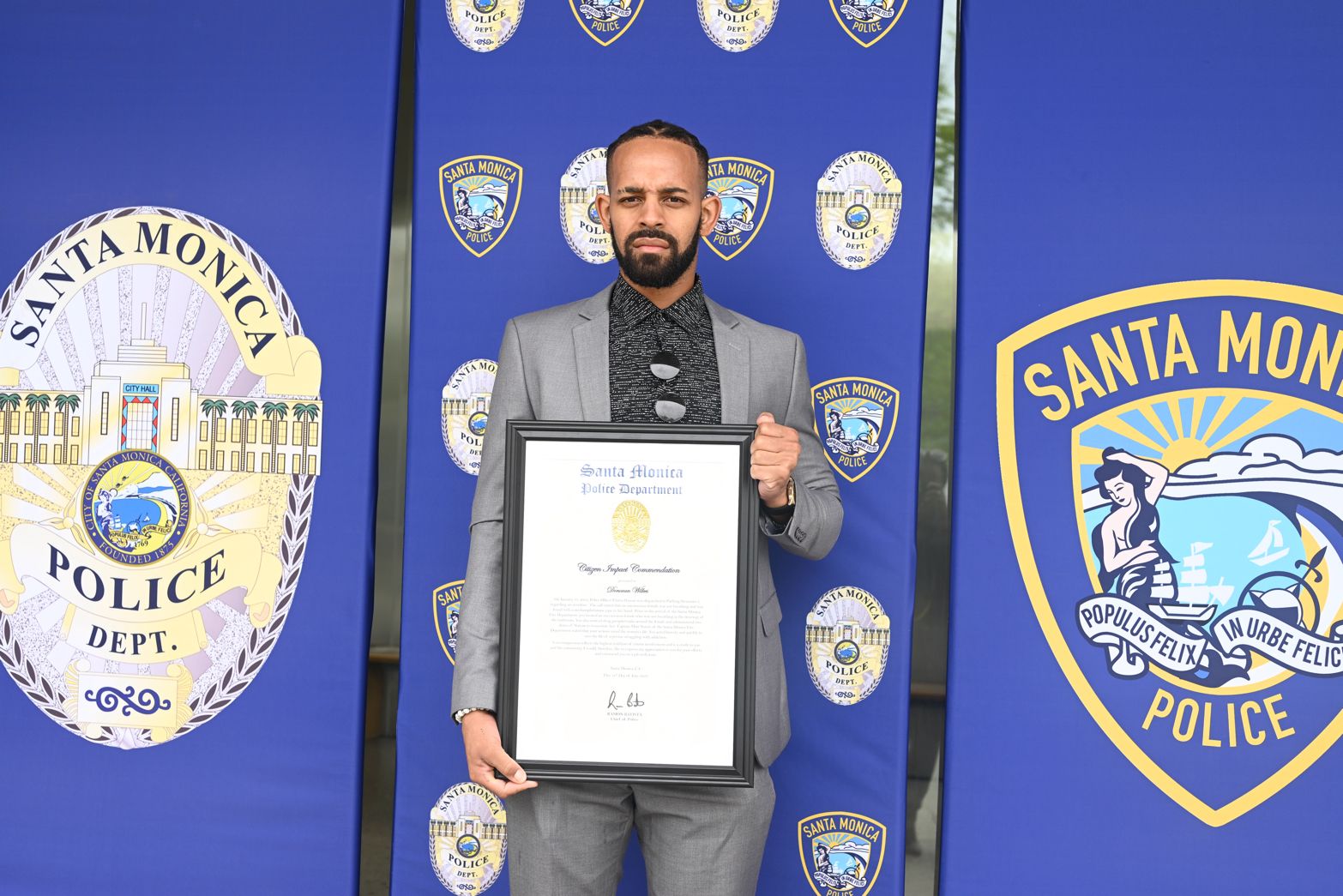
Donovan received The Citizen Impact Award from Santa Monica’s Police Department for his assistance reversing an overdose in 2023.
To read more about Donovan and his work in DTSM, click here.
Getting The Right Information: Advocacy and Nurturing Relationships with Community Providers
Outreach workers are key to helping connect those on the streets with services throughout the city, so those referrals need to reflect accurate information. If a member of the team were to give out incorrect information on services, that could spread quickly through the street population and the team could lose their credibility and respect.
“DTSM’s Outreach Team not only focuses on relationship building for those experiencing homelessness, but also with the local service providers,” Donovan says. “By building these relationships, a sense of trust is created instantly when making warm handoffs from DTSM’s Outreach Team to the local service providers.”
The team often goes into the field alongside workers from various community organizations to meet new people together, make recommendations for services or connect individuals they may already know with the other’s resources.
When not in the field, Donovan spends time researching new resources available to individuals experiencing homelessness. If he finds a new resource, he’ll reach out to the provider to begin fostering a relationship with them, asking to meet for coffee so he can learn more about what they do.
Some of the community partners DTSM Outreach currently works closely with includes:
- The People Concern – a leading housing provider
- The Salvation Army – provides a meal program almost daily and assists people going through detox
- Safe Place for Youth – for youths to get into housing quickly, sometimes even within a week
- St. Joseph Center – another leading housing provider
- West Coast Care – focusing on family reunification by helping individuals find their families and problem solve together
- Department of Mental Health – take on clients who have more severe mental health issues
- Chrysalis – a non-profit assisting with employment
- Clare Matrix – a treatment program for people battling substance abuse
- SMPD’s HLP Unit – an initiative that provides special training and awareness to police regarding people who are experiencing homelessness
“DTSM’s Outreach Team has established strong relationships with those experiencing homeless in DTSM,” Donovan says. “These relationships have resulted from the team continuously checking in with the unhoused and being knowledgeable of resources in the area. By creating these relationships, the Outreach Team is recognized as a reliable support of the [unhoused] community with the [unhoused] population now referring others to inquire about services with DTSM’s Outreach Team.”
BBB Outreach Members are able to work in tandem with social service providers through use of Homeless Management Information System (HMIS), a local information technology system used to collect client-level data and data on the provision of housing and services to individuals and families at risk of and experiencing homelessness.
Social service providers across the country enter data on specific individuals experiencing homelessness into HMIS, including providers they are working with, medical history, where they are from or were last located, whether someone is looking for them and much more. Chico was instrumental in getting DTSM’s Outreach Team access to HMIS, which is usually only given to social service providers.
“It’s typically places like shelters, mental health providers, substance abuse treatment, housing providers and outreach workers at nonprofit agencies,” Chico said. “This is a way for them to track who is helping people and also helps get more funding for those agencies based on metrics…We are not service providers like entities within the Continuum of Care, so we act as a referral source, and we are able to document who is on the streets to keep them on the radar for housing.”
Chico continued, “HMIS is a game changer because it allows our Outreach Workers to get our unhoused people on the housing list without having to depend on other entities. It also allows us to see where our clients are in the process, whether they’re in shelter, case management, substance abuse treatment or housing. We can also see if they have been approved for housing, so we are able to then find our client and do what is needed for the housing before the voucher window expires.”
Donovan’s Team can assess resources they should recommend to a person, add notes, photos or documentation into the system and even help locate missing street residents.
In February of 2023, Donovan’s Team was instrumental in locating someone who was considered “lost.” The Consulate of Sweden came to DTSM looking for a Swedish citizen who had been living in the US for three years as a street resident. In collaboration with the Santa Monica Police Department (SMPD) and BBB’s DTSM Ambassador Program, Donovan was able to locate the missing man.
“[The citizen] was transported to and put into a motel by DTSM where SMPD was able to transport [him] to and from The Consulate’s office to prepare his passport and flight tickets. [He] has since returned to his home in Sweden,” Donovan said.
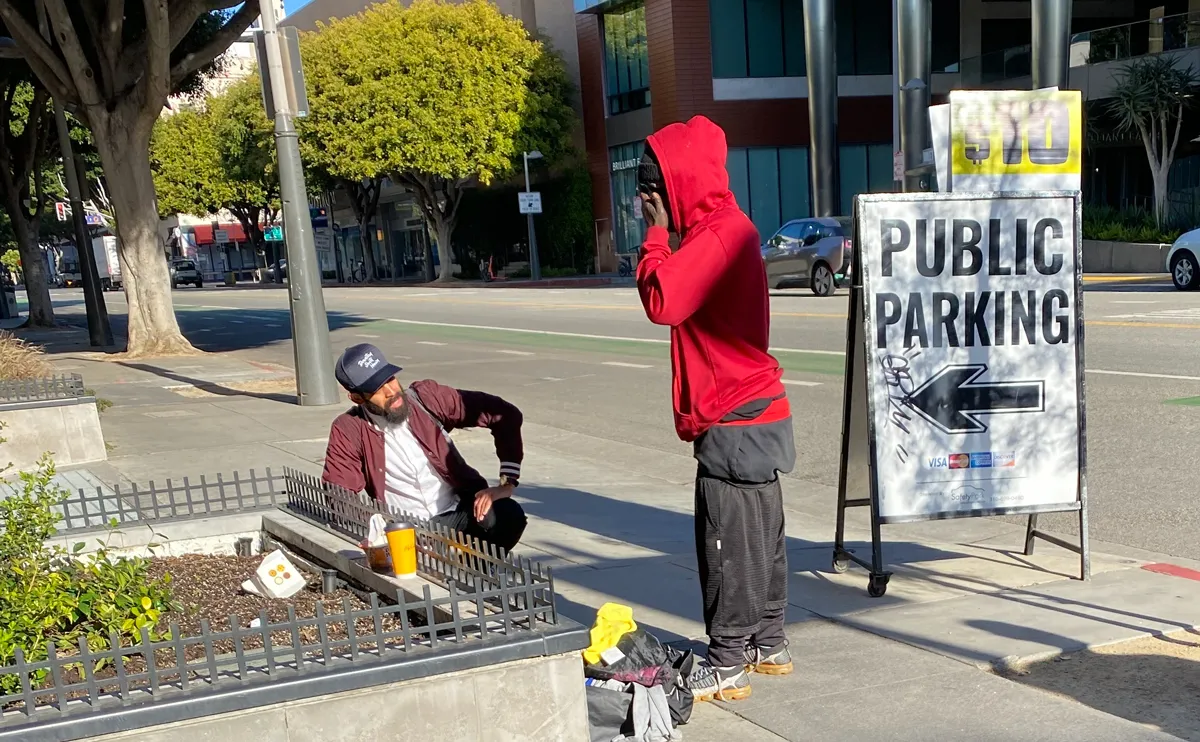
Donovan speaks to a member of the street population.
Perceptions and Realities in DTSM
The City of Santa Monica conducts a yearly “Homeless Count” to determine the number of individuals experiencing homelessness. Between 2022 and 2023, the number of individuals living on the street increased 15%. Donovan co-led the 2024 count, and he said early results appear similar to or slightly higher than the numbers from 2023. He said while data has shown that people experiencing homelessness are finding housing, there are also many individuals exiting housing back to the streets.
“Affordable housing isn’t the most affordable.” Donovan says.
Housing rates have increased, the cost of living is not cheap and there is not enough affordable housing in Los Angeles or Santa Monica. He says that these factors, mental health and drug abuse are major contributors to the number of people living on the streets.
“Even spending a week on the street, your mental health will decrease drastically; living on the street puts you in survival mode,” he said.
When asked about the perception of individuals living on the street versus reality, Donovan says many people just want to be left alone and aren’t necessarily a problem to the public.
“There are a good amount of people who have mental health [concerns] and mix that with substances, can be frightening. Many people are just living their lives and don’t want to be bothered,” he said.
Because the Outreach Team has relationships with individuals living on the street, they are often called to de-escalate “scary” situations. They can address the person who might be causing a scene or other incident by name and ask them what’s going on, putting onlookers at ease and finding a resolution without police involvement.
Donovan recalls a time when his team was called to help with a “notable character” in the district suffering from mental health struggles.
“He did not engage well. He was racist…He did not do well with women either…so, there were gaps with engaging,” Donovan said. “He had severe mental health issues and was a high functioning substance user.”
While he wasn’t the nicest, he did want to get off the streets. So, the team was determined to help him. At one point, they managed to secure him housing, but he was kicked out for his behavior, making it unlikely he would be offered housing again. The team worked tirelessly with him to change his ways and, ultimately, were able to encourage him to take the medicine he had been prescribed to help with the mental health issues he was experiencing.
“He took the medicine [and] his behaviors changed drastically.” After that, Donovan said, he was admitted to housing and is still there today.
What’s Next for DTSM Outreach?
Donovan has many goals for his team in 2024 beyond connecting those experiencing homelessness to local service providers. First and foremost, he wants to build an even stronger relationship with The City of Santa Monica to make the best use of their investment in street-level outreach — ensuring the Human Service Department and DTSM Outreach efforts are in line with one another. To do this, Donovan aims to meet with Santa Monica’s Human Service Department, share DTSM Outreach success stories and plan collaborative events.
Another hope for the future? To get at least one dedicated bed in a local shelter where the team can send a person in need. Currently, the Outreach Team must work through other providers to get individuals in shelters. Donovan dreams of his team being able to directly provide that service to at least one person.
The Big Takeaway
When faced with a problem as large as homelessness, it is hard to imagine a way to effect real change. Donovan and his team are the boots on the ground doing just that — putting in the time, building relationships and trust with people living on the streets and guiding them in the right direction to live better lives.
What Donovan finds rewarding about his work is these relationships he builds and the growth he sees in many thanks to the help of the right connections. He watches and reflects on each person’s journey from those first interactions when they may be down on their luck, to those moments when they are housed and on the other side.
While the work may not always be easy, Donovan and his team are dedicated to making a real difference in DTSM. More than anything, Donovan wants people to know his team’s purpose: “To bridge gaps in communities by empowering people and promoting resources with a compassionate approach.”
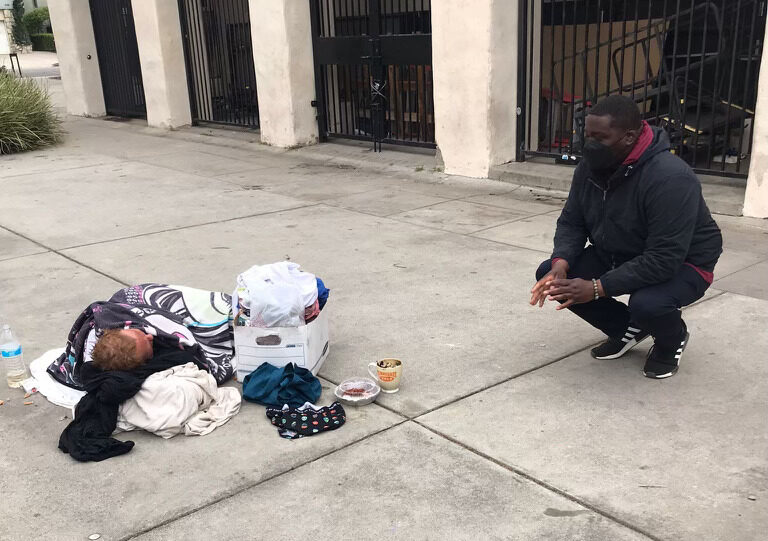
Ambassador Marc checks on a street resident.